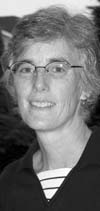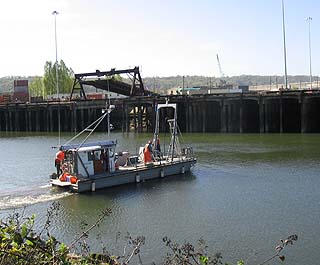
Surveys
DJC.COM
July 29, 2004
Quick Duwamish cleanup begins with teamwork
Integral Consulting

Day
|
In 2000, a partnership of the city of Seattle, King County, the Port of Seattle and the Boeing Co. launched an aggressive early cleanup plan to speed environmental relief to the waterway while balancing economic viability needs of businesses. The partners, known as the Lower Duwamish Waterway Group (LDWG), are committed to achieving the most effective cleanup possible by using science-base strategies.
Since the late 1890s, the banks of the Duwamish River have supported numerous industrial, residential, commercial and recreational activities. Dredging by the U.S. Army Corps of Engineers between 1915 and the early 1920s completed the Lower Duwamish Waterway that extends about five miles upriver from the south end of Harbor Island.

Photo by Jennie Goldberg
Samples were taken in April in Slip 4 as part of the early action program for the Lower Duwamish Waterway.
|
The legacy of a century of urbanization and industrial development along the Duwamish has been the degradation of water quality and sediment quality, and the associated loss of wildlife habitat and resource use.
Beginning in 1948, the reduction and eventual elimination of industrial and raw sewage discharges to the Duwamish, and the implementation of source control best management practices, have improved water quality in the river. The current emphasis for environmental improvement in the waterway focuses on the cleanup of contaminated sediments, the restoration of critical habitat, and the continued identification and control of sources of contamination.
LDWG partners voluntarily agreed to work together to further improve the health of the river, even before the roughly five-mile stretch was declared a federal Superfund site in 2001. Studies showed that sediments in the river were contaminated with polychlorinated biphenyls and, to a lesser degree, metals and other organic chemicals. The partners signed a voluntary agreement with the U.S. Environmental Protection Agency and the state Department of Ecology to implement a remedial investigation and feasibility study.
By following EPA guidance, LDWG is using the best available science to identify areas of sediment that pose unacceptable risks to human health or the environment, and will develop alternatives for the cleanup of those areas. Once this traditional process is complete (estimated for 2007), areas identified for cleanup will be subjected to comprehensive engineering design prior to cleanup.
Early action areas
Between 1989 and 1998, more than 1,000 sediment samples from the Lower Duwamish Waterway were collected and analyzed by public and private entities. This wealth of information provided an enormous head start in the remedial investigation/feasibility study process because data already existed that identified areas with contaminated sediment.
LDWG proposed to speed up the cleanup work by using this available information to identify known hot spots that could be cleaned up much sooner, and as a result an early step in the ongoing remedial investigation/feasibility study process identified seven areas for early sediment cleanup actions.
Boeing's Plant 2 site, the Diagonal/Duwamish site and the Norfolk site were included in this list of seven candidate sites although they were already in various stages of cleanup. Sediment cleanup surrounding the Diagonal/Duwamish outfall occurred a few months ago. Two cleanups, one three years ago and a more recent one last summer, have been completed at the Norfolk outfall.
Two of the remaining four sites have sponsors and early action work is well under way. The cleanups at Terminal 117 and Slip 4 will be conducted under EPA's guidance for non-time critical removal actions, and will be considered interim actions. The traditional Superfund process will continue to be followed for the Lower Duwamish Waterway and will address all remaining sediments beyond the early action areas. Additional cleanup areas may be identified through this process.
The Port of Seattle, as the lead entity, and city of Seattle have completed sampling at Terminal 117 to establish a preliminary boundary of the removal action and have submitted their recommendations for the early action removal boundary to EPA and Ecology.
Once the preliminary boundary has been approved by these agencies, an engineering evaluation and cost estimate will be prepared that will describe and evaluate the various cleanup alternatives. Following a public review of this evaluation and its approval by EPA and Ecology, the engineering plans and specifications will be developed, with cleanup commencing in 2005 or 2006. Work on this site is led by Windward Environmental.
The city of Seattle, as the lead agency, and King County are working together on Slip 4. This early action site is following the same process as Terminal 117, but began about six months later. Sampling is complete, and a preliminary boundary of the removal action will be recommended to EPA and Ecology in fall 2004. The city and county plan to initiate sediment remediation within Slip 4 in 2006. Early action work on this site is being conducted by Integral Consulting.
Source control
A new broad source control effort was initiated for the Lower Duwamish Waterway in 2002. The purpose of this effort is to prevent recontamination of sediments following cleanup. The project involves: inspection of wastewater and combined sewers, stormwater drainage systems and waterfront properties; enforcement of existing regulations; and identification of best management practices that businesses can use to prevent pollution.
In an innovative approach, several regulatory programs have been combined to require only one inspection for each business unless the inspectors find problems that need follow-up visits. Inspections under this program began in the Diagonal/Duwamish drainage basin in 2003. Once inspections in this basin have been completed, the program will focus on drainage basins that drain to other early action areas.
Benefits
Early actions like these are a great benefit to the river as they will allow the removal of contaminated sediments far earlier than would have occurred following the standard Superfund process.
By moving forward with both EPA's traditional Superfund process and the early actions, the public can be assured that high-priority areas are being addressed rapidly and at the same time the rest of the waterway is being studied to determine whether other areas present unacceptable risks. This is a significant net benefit to the health of the waterway, the people who live, work and play on the Duwamish, the natural resources that reside in and along the banks of the waterway, and to tribal and recreational fishers.
Betsy Day is a marine biologist whose environmental consulting practice focuses on the strategic and technical aspects of contaminated sediment sites.
Other Stories:
- Conditional closures — another cleanup remedy
- Washington tests watershed management
- Todd Pacific halts a dirty waterfront legacy
- Going green? Try calling on your contractor
- Emerald City must fight to stay green
- Seattle prepares to ‘re-green' 2,500 acres
- Washington's new paint law gets the lead out
- Putting a price tag on nature
- South Lake Union: a model for sustainability
- Guy Battle: design and build to suit your climate
- Contractor finds silver at new headquarters
- Government finds gold at Sea-Tac Airport
- 2004: A great year for the local environment
- Getting to compliance with a systems approach
- Don't let your site be taken to the cleaners
- Salmon get a boost from technology
- Low-impact development comes to Pierce County
- Energy Star label now ready for homes
- Improving traffic flow for fish, people
- Troubling times for Hood Canal's waters
- Utilities to study energy coming into homes
Copyright ©2009 Seattle Daily Journal and DJC.COM.
Comments? Questions? Contact us.